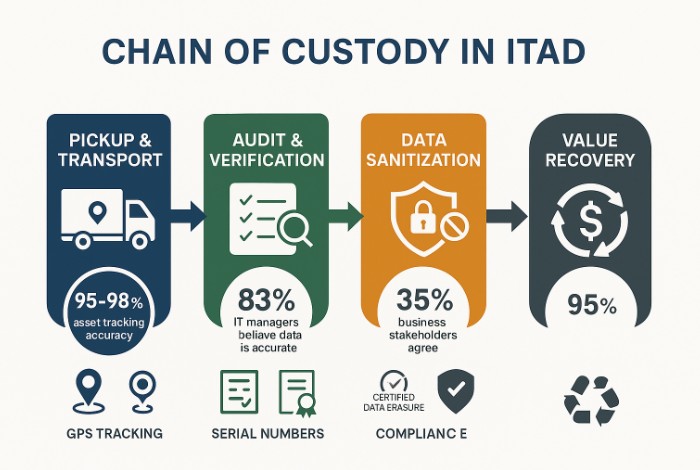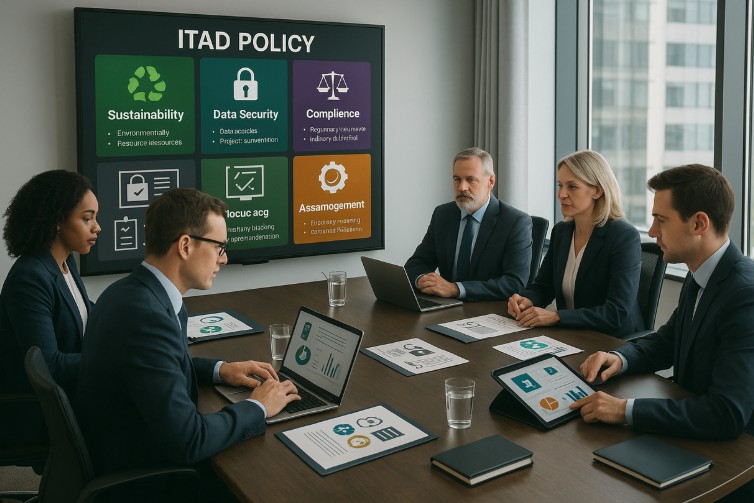Proper handling of IT equipment during transport is essential.. Secure logistics services offer specialized solutions for transporting valuable tech assets between locations to not only prevent physical damage but also maintain data security and compliance.
When shipping servers, computers, or other sensitive technology, standard shipping methods often fall short. Companies like DMD Systems Recovery provide comprehensive services including proper packaging, coordination, and secure transport options.
Some providers even offer satellite and GPS tracking to monitor assets in transit and ensure equipment never leaves authorized custody.
Regardless of the reason for relocation, proper planning an IT move requires careful consideration. This includes packaging needs, transport security, and chain of custody documentation. Professional services can help you navigate these logistics challenges. They also provide peace of mind that your valuable technology assets remain protected throughout transit.
Secure Logistics Fundamentals
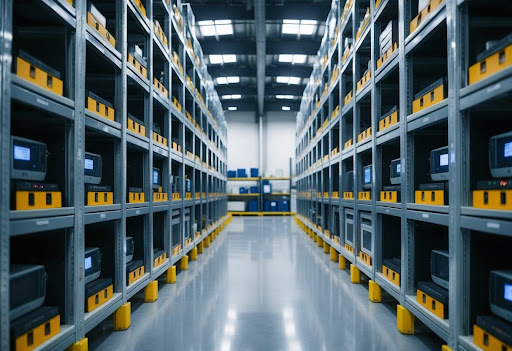
Protecting IT equipment during transport and storage requires specialized procedures and vigilant oversight. Secure logistics combines traditional supply chain management with advanced security measures to ensure valuable technology assets remain safe throughout their journey.
Defining Secure Logistics
Logistics security encompasses all processes and procedures implemented to identify, analyze, and mitigate risks in your supply chain. When applied to IT equipment, it involves specialized handling that protects both the physical assets and the data they contain.
Secure logistics for IT equipment includes:
- Physical protection: Tamper-evident packaging, locked containers, and GPS tracking
- Chain of custody: Documented handling at every touchpoint
- Inventory management: Real-time tracking and verification systems
- Risk assessment: Analysis of vulnerabilities in transport routes and storage locations
A secure logistics process should create a seamless, transparent system that maintains full visibility of IT assets from pickup to final destination. This includes proper training for all personnel who handle sensitive equipment.
Importance of Security in Logistics
Security breaches in IT logistics can lead to significant financial losses, data exposure, and damaged reputation. Full logistics security ensures your equipment remains protected throughout transport, receiving, and processing phases.
Key benefits of prioritizing security include:
- Enhanced customer satisfaction through reliable delivery and data protection
- Reduced risk of theft, tampering, or damage in transit
- Regulatory compliance with data protection laws and industry standards
- Cost savings by preventing losses and avoiding potential fines
- Stronger partner and vendor relationships built on trust and accountability
Implementing robust security measures also gives you a competitive advantage. Clients increasingly demand assurance that their technology investments will be handled with appropriate care and protection.
Risk Management in IT Equipment Logistics
Managing risks in IT equipment logistics requires a strategic approach to identify threats and implement protective measures. Effective risk management enhances visibility across the supply chain while ensuring optimal performance during transport and delivery.
Identifying Potential Risks
Risk identification is the critical first step in securing your IT equipment supply chain. Supply chain risk management begins with cataloging potential vulnerabilities unique to technology assets.
Common IT logistics risks include:
- Physical damage during transportation
- Theft of valuable or sensitive components
- Environmental hazards (temperature, humidity, static)
- Chain-of-custody breaches
- Data security vulnerabilities
- Counterfeit parts entering your inventory
Be sure to conduct regular risk assessments that include input from logistics partners, IT security teams, and compliance officers. Also, document historical incidents to establish risk patterns and identify weak points in your logistics network. This data-driven approach helps prioritize which risks require immediate attention based on likelihood and potential impact.
Utilizing tracking technologies provides real-time monitoring of equipment location and handling conditions throughout the process.
Minimizing Risks and Mitigating Threats
Once risks are identified, implement a multi-layered protection strategy. Effective logistics risk management helps ensure a secure and resilient supply chain for your IT equipment.
Best Practices for Risk Mitigation:
- Select logistics partners with proven security credentials. Require partners to demonstrate compliance with industry standards and specialized IT handling protocols.
- Use tamper-evident packaging, GPS tracking for high-value shipments, andAnti-theft devices and tagging systems.
- Confirm secure transportation with appropriate environmental controls
- Improve performance through redundancy planning. Have backup suppliers, alternative shipping routes, and contingency storage locations ready for deployment.
- Implement a supply chain risk management (SCRM) program that includes regular audits and improvement cycles. Test your response plans with simulated disruptions to identify gaps.
- Train your team to recognize and report suspicious activities in the supply chain. Your staff serves as a critical early warning system for potential security issues.
Technological Advancements in Logistics

Technology is rapidly transforming secure logistics operations for IT equipment, creating more efficient and protected supply chains. From real-time tracking to automation, modern solutions significantly reduce human error and vulnerability.
Automation in Secure Logistics
Automation has revolutionized how IT equipment moves through the supply chain. Robotic process automation (RPA) now handles repetitive tasks like inventory management and shipment scheduling with minimal human intervention, reducing security risks from manual handling.
Automated warehouses employ sophisticated systems including:
- Robotic arms for precise handling of sensitive components
- Conveyor systems with RFID checkpoints
- Computer vision systems that verify package integrity
These systems also create digital audit trails, documenting every movement of your IT assets from origin to destination. Organizations using automation implementations can expect up to 15% reduction in logistics costs.
Emerging technologies like autonomous vehicles are beginning to transform secure transport, with GPS-tracked routes and tamper-evident containers that alert security teams instantly if compromised.
The Role of IoT and Its Impact on Security
The Internet of Things (IoT) has created unprecedented visibility in IT equipment logistics. Smart sensors now monitor everything from location to environmental conditions during transit.
Your sensitive IT equipment benefits from IoT devices that can:
- Track precise GPS location in real-time
- Monitor temperature, humidity, and shock levels
- Detect unauthorized access attempts
- Verify chain of custody through digital signatures
IoT sensors communicate with centralized systems to create constant awareness of your equipment’s status. If environmental thresholds are exceeded or security is compromised, you receive immediate alerts.
For even greater transparency, the integration of IoT with blockchain technology provides immutable records of each transfer of custody, ensuring verification at every step of the logistics process.
Asset Tracking Systems
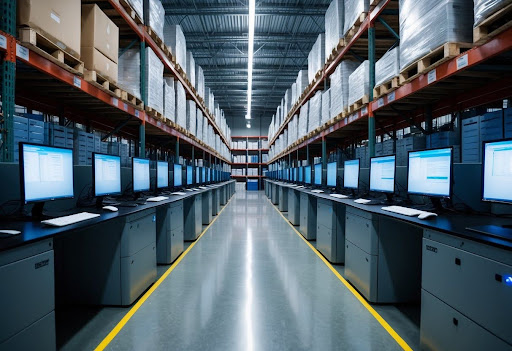
Asset tracking systems provide essential visibility into the location, usage, and status of your IT equipment throughout its lifecycle. These systems help prevent loss, optimize utilization, and enhance security for valuable technology assets.
Real-Time Asset Tracking Technologies
Modern real-time asset tracking relies on several key technologies that offer different benefits depending on your needs. Here’s an overview of the most commonly used systems:
RFID (Radio Frequency Identification)
- Passive tags require no power source and work well for inventory management
- Active tags contain batteries and can transmit data over longer distances
- Ideal for tracking multiple assets simultaneously without line-of-sight
GPS Tracking
- Provides real-time location data for outdoor assets
- Can establish geofences to alert you when assets leave designated areas
- Ideal or tracking vehicles and equipment in transit
Barcode and QR Code Systems
- Cost-effective implementation for smaller operations
- Requires manual scanning, but offers reliable identification
- Platforms like AssetTiger provide free barcode-based solutions for small businesses
Bluetooth Beacons
- Work well for indoor tracking where GPS isn’t effective
- Provide proximity-based location data
- Low power consumption for extended deployment
Integrating Asset Tracking with IT Equipment
Integrating tracking systems with your IT equipment creates a seamless management ecosystem. This integration enables you to track IT assets throughout their entire lifecycle—from procurement through deployment, maintenance, and eventual disposal.
Modern platforms allow you to attach critical information to each asset record including:
- Maintenance schedules and history
- User assignments and location data
- Warranty information and expiration dates
- Compliance documentation
Cloud-based solutions provide accessibility from anywhere. This allows your team to update asset information in real-time during logistics operations. This ensures all stakeholders have current information.
Implementation Best Practices:
- Start with high-value assets first
- Standardize your tagging protocols
- Train staff thoroughly on the system
- Establish regular auditing procedures
Integration is key: your tracking system should integrate with existing inventory and help desk systems. This eliminates data silos and improves operational efficiency.
Inventory Management for IT Equipment
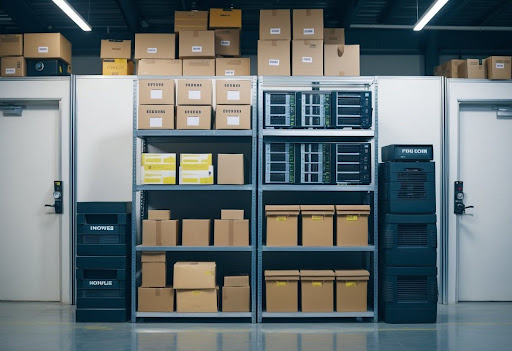
Effective IT inventory management is crucial for tracking, securing, and optimizing your technology assets. Proper management ensures you know exactly what equipment you have, where it’s located, and its current status.
Securing Inventory Data
Protecting your inventory data is as important as securing the physical assets themselves.
Best Practices for Inventory Data Security:
- Implement role-based access controls to limit who can view or modify inventory records. This prevents unauthorized changes and creates accountability.
- Schedule regular backups of inventory data should be part of your security routine. Store these backups in secure, off-site locations to ensure recovery is possible if primary systems fail.
- Use encryption for sensitive inventory information, especially when it contains details about security vulnerabilities or asset locations.
- Consider these security measures as an extra level of protection:
- Two-factor authentication for inventory system access
- Audit logs to track who accessed or modified records
- Secure API connections for any integrated systems
- Regular security assessments of your inventory platform
Inventory Optimization Techniques
Creating a comprehensive equipment inventory list is your foundation for optimization. Start by categorizing assets by type, location, and criticality to operations.
Use barcode or RFID tagging systems to automate data collection and reduce human error. These technologies make regular audits faster and more accurate.
Key optimization strategies include:
- Implement lifecycle management tracking to identify aging equipment before it fails.
- Set minimum and maximum inventory levels for consumables and replacement parts.
- Track usage patterns to predict future needs.
- Analyze repair histories to identify problematic equipment models.
- Monitor equipment status in real-time when possible.
Using specialized IT inventory management software can streamline these processes. These tools help you maintain visibility across distributed locations and ensure nothing falls through the cracks.
Client Experience in Secure Logistics
The success of secure logistics for IT equipment hinges on creating positive client interactions and building trust through open communication. Effective logistics providers understand that security must be balanced with excellent service delivery.
Enhancing Customer Trust and Satisfaction
Building trust in secure IT logistics requires consistency and proven security measures.
When you choose a logistics provider, look for those with transparent tracking systems that allow you to monitor your equipment throughout the transport process. Secure logistics experts can help optimize your risk management while solving security challenges.
Your peace of mind comes from:
- Verified chain of custody documentation
- Regular status updates at predetermined checkpoints
- Certified handling procedures for sensitive equipment
Customer satisfaction increases when logistics providers customize their approach to your specific needs. ITAD Tech offers solutions that can be tailored to your security, asset, and facility requirements. This personalization ensures your unique concerns are addressed.
Transparency and Communication Strategies
Clear communication forms the backbone of successful secure logistics operations. You deserve to know exactly what happens with your IT assets during transportation and processing.
Effective providers implement:
- Real-time tracking dashboards
- Dedicated account representatives
- Detailed reporting protocols
- Proactive notifications with clear timelines and any deviations from the plan
Transport and logistics companies are increasingly focusing on customer experience as a key differentiator.
With that, risk communication is equally important. Logistics security processes identify, analyze, and mitigate risks in your supply chain and the provider should explain these risks and their mitigation strategies in straightforward language. This transparency helps you make informed decisions about your IT equipment’s handling.
Evaluating Logistics Performance
Measuring the effectiveness of your secure IT equipment logistics requires systematic assessment of key metrics and ongoing process refinement. Regular evaluation helps identify vulnerabilities, inefficiencies, and opportunities for improvement in your security protocols.
Key Performance Indicators (KPIs)
Tracking specific logistics KPIs is essential for objective evaluation of your IT equipment transport operations. Your metrics should include both security and operational performance measurements. Here are some examples:
Security-focused KPIs:
- Incident rate (number of security breaches per shipment)
- Chain-of-custody compliance percentage
- Percentage of shipments with tamper-evident seals intact
- Time to detect and respond to security alerts
Operational KPIs:
- On-time delivery rate
- Average transit time
- Damage rate during transport
- Inventory accuracy
Implementing database management systems helps you track these metrics efficiently.
Establish performance baseline measurements that use scorecards or dashboards to visualize trends, then set reasonable targets for improvement.
Continuous Improvement in Secure Logistics
Your logistics system requires regular refinement to address emerging threats and inefficiencies.
Examining your logistics system systematically helps identify problem areas requiring intervention. Here are steps for continuous improvement:
- Start by analyzing underperforming KPIs to identify root causes of issues.
- Conduct periodic security audits and vulnerability assessments to identify weaknesses before they become problems.
- Encourage employee feedback from transportation and security teams to report concerns or suggest process enhancements.
- Consider technology upgrades, including new tracking systems, authentication methods, and security technologies at least annually.
- Evaluate each upgrade for its impact on both security and operational efficiency.
Document all improvement initiatives with clear objectives, timelines, and success metrics. After implementation, measure results against your baseline KPIs to verify actual performance improvements and ROI.
Frequently Asked Questions
Securing IT equipment during transport requires careful planning and execution. Many organizations have important questions about the logistics process for their valuable tech assets.
How can IT equipment be protected during transport?
Proper packaging is the first line of defense for IT equipment in transit. Use the following:
- Anti-static materials and custom foam inserts to prevent movement inside boxes
- Double-boxing with sturdy outer containers and shock-absorbing materials between boxes provide additional protection.
- Climate-controlled shipping options to protect equipment from temperature extremes, humidity, and precipitation
Document the condition of all items before shipping with photos and detailed descriptions. Always get adequate insurance for your equipment based on its true replacement value.
What are the best practices for data center logistics management?
- Create a detailed inventory management system that tracks each piece of equipment throughout its lifecycle including serial numbers, purchase dates, and maintenance records.
- Develop clear procedures for equipment receiving, installation, and decommissioning.
- Use specialized equipment like server lifts and anti-static tools when handling data center components to minimize physical damage and data loss.
- Schedule deliveries during low-traffic periods to reduce operational disruptions and risk of accidents during installation.
Which security measures are essential in IT equipment logistics?
- Background checks for all personnel handling sensitive equipment, including both in-house staff and third-party logistics providers.
- A chain of custody documentation system that tracks who handles equipment at each stage—every handoff being recorded and verified.
- Tamper-evident seals on packages containing IT equipment to provide visual evidence if someone has attempted to access the contents
- Real-time tracking and monitoring systems to verify the location and condition of shipments at all times—any of which include temperature and impact sensors
What qualifications should I look for in a logistics provider specializing in tech equipment?
When selecting a logistics provider for IT equipment, experience with IT equipment specifically is crucial.
- Relevant experience: Ask for case studies or references from similar clients in your industry.
- Certifications: Look for industry-recognized certifications, such as R2 and ISO 45001.
- State-of-the-art facilities and technology: Designed specifically for handling electronic equipment, these should include climate control and specialized handling tools.
- Insurance coverage: Verify that your provider carries adequate insurance to cover the full value of your equipment.
What are some common risks involved with transporting IT equipment and how can they be mitigated?
Physical damage is a primary concern during shipping. Mitigate this through professional packaging, handling, and transportation in vehicles with air-ride suspension.
Data breaches can occur if equipment containing sensitive information is compromised. Always encrypt data and consider wiping devices before transport when appropriate.
Logistics security processes should identify and analyze risks specific to your supply chain. Develop contingency plans for potential disruptions.
Theft presents a significant risk for valuable IT assets. Use unmarked vehicles, confidential routing, and security escorts for especially valuable shipments.
Environmental factors like extreme temperatures or humidity can damage sensitive electronics. Use climate-controlled transportation and monitor environmental conditions during transit.
Understanding these risks and planning ahead helps your equipment arrive safely and securely.



